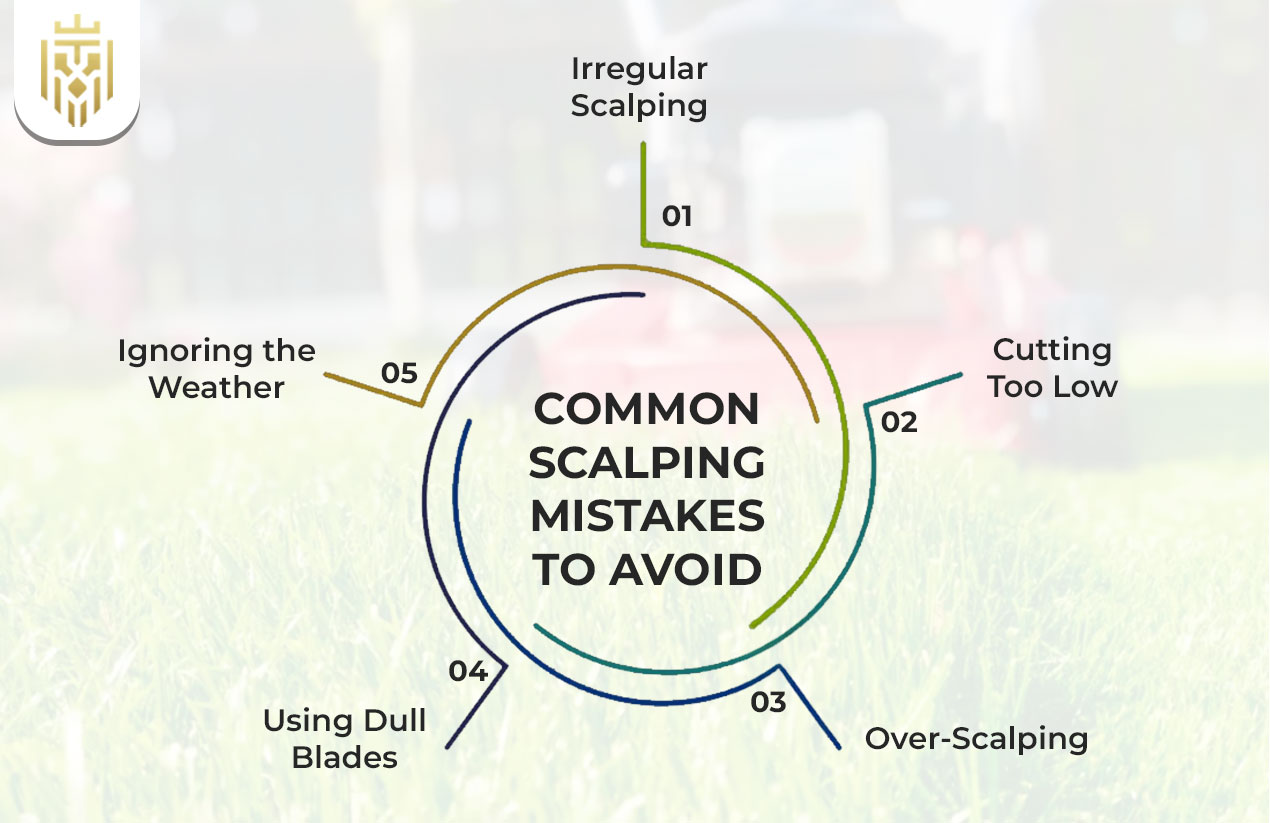What is Lawn Scalping?
Lawn scalping refers to the practice of mowing grass to a very short length at the beginning of the growing season to clear off old growth and rubble. The method enhances the penetration of sunlight and promotes healthier grass. Knowledge about the appropriate lawn mowing techniques guarantees a healthy and strong lawn all year round.
Benefits of Scalping Your Lawn

Lawn scalping has the following advantages: dead grass removal, fresh growth, and disease prevention. Healthy grass: Scalping healthy grass makes roots stronger and enhances the general looks. Together with regular mowing and a well-serviced lawn mower, it cleans your lawn to grow optimally.
Removes Thatch and Debris
Great methods of lawn scalping can eliminate thatch and debris. Eliminating this layer can stop any fungus and contribute to the more efficient growth of grass blades. Cleaning up adequately will also ensure that nutrients and water infiltrate the soil, sustaining a healthier and more robust lawn ecosystem.
Encourages New Growth
Scalping will cause dormant grass to grow. Through appropriate lawn scalping techniques, you promote a thick lawn with a covering of rich green growth. This process is most effective when implemented with fertilisation and regular grass-cutting schedules to have a smooth and healthy lawn.
Prepares for Overseeding
Mowing the lawn leaves the best environment to be applied to overseeding. When the old grass and debris are removed, it opens the soil to better contact with the seeds. Precautionary steps taken after scalping the lawn will ensure that the new grass grows fast, leading to a more complete and even lawn.
Reduces Disease and Pests
Creating shorter grass decreases the amount of moisture the grass can retain and minimises places where pests and fungal diseases can multiply. Healthy grass lawn scalping helps reduce the risk of disease, enhance airflow, and avoid infestations, thus making your outdoor space safer and your lawn mower work more productive when it comes to routine grass cutting.
Improves Water Absorption
Scalping enhances the penetration of water and nutrients in the soil by reducing the excess thatch and dead growth. Good soil has a greater capacity to absorb rain, minimising run-off. Good scalping techniques increase water efficiency and also deeper root growth, resulting in resilient and drought-tolerant grass.
Enhances Lawn Appearance
A newly trimmed lawn is smooth. Lawn mowing methods eliminate irregularities, dull mows, and debris, making your lawn look manicured. Together with regular seasonal maintenance and regular mowing, this enhances the kerb appeal and health of the lawn in general.
When to Scalp Your Lawn?
It is important to know the right time to scalp your lawn in order to ensure maximum growth. The time of the year cold-season and warm-season lawn grass recover is different, and this guarantees the existence of healthy roots. Stress-free steps that involve proper scalping of the lawn lead to new growth and improvement of the overall look of the lawn during the season.
Cool-Season Grass
Scalping early in spring is beneficial to cool-season grass such as fescue or bluegrass. Scalping of the lawn to ensure healthy grass before the commencement of new growth will enable the roots to develop, making the lawn dense and green with the grass cutter and fertiliser ready to start.
Warm-Season Grass
Scalping of warm-season grasses (Bermuda or Zoysia) should occur late in the spring or at the beginning of the summer. Timely shortening of grass will enhance quick growth, more sunlight will be absorbed, and disease will not develop, making sure that your lawn mower cuts the grass trimmed effectively.
How to Scalp a Lawn?

Scalping a lawn entails mowing grass down, clearing the soil and aerating the soil optionally. Correct lawn scalping methods will keep stress to a minimum, promote healthy growth, and get the lawn ready to receive fertilisers or overseeds, making your grass flourish and live well.
Choose the Right Time
Scalping depends on timing. To ensure maximum output, your lawn needs to be scaled in times of growth. The right season will guarantee a healthy grass lawn scalping, reduce stress, and offer a solid base on which the following fertilisation and grass cutting schedule will rely on.
Mow the Lawn Concisely
Start with reducing your lawn mower slowly. It is important not to cut too aggressively at a time. By using appropriate steps to scalp the lawn, one can prevent damage caused to the lawn, eliminate dead growth and have the grass regenerating faster, which results in a healthier and more even lawn.
Remove Debris and Thatch
Once mowed, rake off scraps and residual thatch off the lawn. This stops disease, enhances air flow and aids in the absorption of nutrients. The methods of lawn scalping advise proper cleanup to enable preparation of the lawn to be overseeded or to be fertilised or to be taken care of seasonally.
Aerate the Soil (Optional)
The penetration of roots and soil health can be enhanced by aeration post-scalping. Though not essential, this non-obligatory action improves the absorption of water and nutrients. With healthy lawn scalping, aeration enhances the health of the lawn, and the grass cut that follows becomes easier and more effective.
Fertilize and Water
Fertiliser and water application after scalping stimulate the growth of the grass and replenish the nutrients that have been affected by cutting. A combination of appropriate lawn scalping techniques and hydration will help in having a quick recovery of the grass to provide a healthy, dense lawn that is resistant to both weeds and disease.
Overseed if Needed
Scalping makes the lawn ready to be overseeded by eliminating old grass and leaving the soil available. It is important to add seeds following the right procedures of scalping the lawn so that it grows well and uniformly. More frequent lawn mowing and added overseeding harden your lawn to stressors.
Common Lawn Scalping Mistakes to Avoid

It is important to avoid errors when scalping a lawn. Mowing too low or scalping at the inopportune moment and working with a dull lawn mower may cause damage to grass and roots. Knowing how and when to achieve healthy recovery helps avoid the risk of disease or poor growth.
Irregular Scalping
Scalping in the wrong season may cause pressure on grass and stunt growth. Lawn scalping with the guidelines of healthy grass timing will guarantee that the timing of the lawn scalping matches the seasonal growth so that your lawn gets the maximum opportunity of recovery and flourishing between the typical lawn cutting periods.
Cutting Too Low
Low mowing may over kill roots, retard growth and expose the plant to pests. Best practices in lawn scalping lay stress on slow height reduction, compromising between removing the debris and retaining healthy grass at sustainable and healthy levels.
Over-Scalping
Constant scalping makes grass weak and can cause patchy grass. Laying off lawn scalping strategies at intervals as recommended keeps the roots strong, promotes better healing, and allows a regular cutting of grass without undue stress over your lawn.
Using Dull Blades
Lawn mower blades are not sharp enough to cut grass and raise the risk of diseases. Blades that are sharp will provide clean cuts in the lawn scalping, which will cause the lawn to heal quicker with minimal stress on the lawn, resulting in healthier growth and an even, beautiful lawn.
Ignoring the Weather
Scalping in bad weather may result in dampening your lawn. Evading drought, frost, or excessive rainfall makes sure that scalping of the lawn of healthy grass is a successful one. With the appropriate planning and frequent mowing, the lawn will recover soon and be resilient.
FAQs
1) What is Lawn Scalping?
Lawn scalping is using a mower to cut grass so short as to remove old growth and debris. The right procedures of scalping lawns enhance exposure to sunlight, promote healthy grass and set lawns to be overseeded and grow better.
2) What Are the Benefits of Scalping a Lawn?
Lawn scalping has many advantages, such as the removal of thatch, encouraging new growth, decreasing pests, and enhancing water uptake. Healthy grass lawn scalping will make roots more resilient, will beautify it and will aid in regular grass trimming.
3) When Is the Best Time to Scalp Your Lawn?
The most appropriate time varies according to grass. It is best to have cool-season grass during the early spring, and warm-season grass should be scalped during late spring or at the beginning of summer to get the best lawn scalping outcomes.
4) How to Scalp a Lawn?
Scalping a lawn requires cutting grass with a sharp lawn mower over time, clearing up debris, possibly aerating soil, fertilising, and optionally overseeding, by means of healthy grass cutting techniques.









